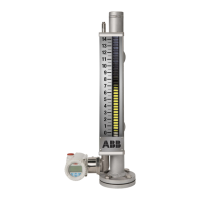The transmitter can be calibrated with any range between the
LRL and the URL with the following limitations:
Factory settings
Transmitters are calibrated at the factory to the customer’s
specified measuring range. The calibrated range and tag
number are provided on the tag plate. If this data has not been
specified, the transmitter is delivered with the following
configuration:
Parameter Factory setting
Upper range value (URV)
Damping
Transmitter failure (alarm)
HMI Default Operator Page
(Optional)
IMPORTANT NOTE
All of the configurable parameters on the left can be easily
modified either through the optional HMI (with a HART
handheld terminal) or a compatible software solution.
Information regarding,
Configuration types
Level transmitters can be configured as follows:
• Configuration of the parameters for the lower and upper
range values (via Zero and Span push buttons), without an
integral HMI using the local push buttons.
• Configuration of the level transmitter using the integral HMI
with keypad (menu-controlled)
• Configuration with a handheld terminal
• Configuration using a PC/laptop via the graphical user
interface (DTM)
Configuring the transmitter without an
integral HMI
LMT Series level transmitters allow local adjustments via the
onboard non-intrusive push buttons, when selected. The push
buttons are located under the identification nameplate. To gain
access to the local adjustments, release the attaching screws
on the nameplate and rotate the identification plate clockwise.
WARNING – Potential damage to
parts.
Operating the control buttons with a magnetic screwdriver
is not permitted.
The lower range value and span parameters can be set directly
on the transmitter, using the external push buttons.
The transmitter is calibrated by the manufacturer, based on the
order information. The tag plate contains information on the
“lower range value” and the “upper range value” set. In general,
the following applies:
LRV and URV configuration (4-20 mA ranging) using local push
buttons
• Apply the level for the lower range value and wait until the
signal has stabilized.
• Press the “Z” button. This sets the output current to 4 mA.
• Apply the level for the upper range value and wait until the
signal has stabilized.
• Press the “S” button. This sets the output current to 20 mA.
If required, reset the damping to its original value.
Record the new settings. The respective parameter is stored in
the non-volatile memory 10 seconds after the “Z” or “S” button
is pressed.
IMPORTANT NOTE
This configuration procedure only changes the 4-20 mA current
signal. It does not affect the physical process level (PV value),
also shown on the digital display or user interface. After
performing a correction, check the device configuration.
Configuring the transmitter using the
optional integral HMI - Through the Glass
(TTG) (L2 option)
The integral HMI is connected on the LMT Series
communication board. It can be used to visualize the process-
measured variables as well as to configure the display and the
transmitter.
The TTG technology allows the user to activate the keypad on
the HMI without the need of opening the windowed cover of
the transmitter. The capacitive pickups detect the presence of
the user’s finger in front of the respective button, activating
the specific command. At the transmitter power-on, the HMI
automatically calibrates its sensitivity. It is mandatory for the
proper functioning of the TTG HMI that the cover is sufficiently
tightened at power-on.
In case the cover has been removed to access the
communication board, it is recommended to power off and
power on the transmitter once the windowed cover has been
set in place and properly tightened.

